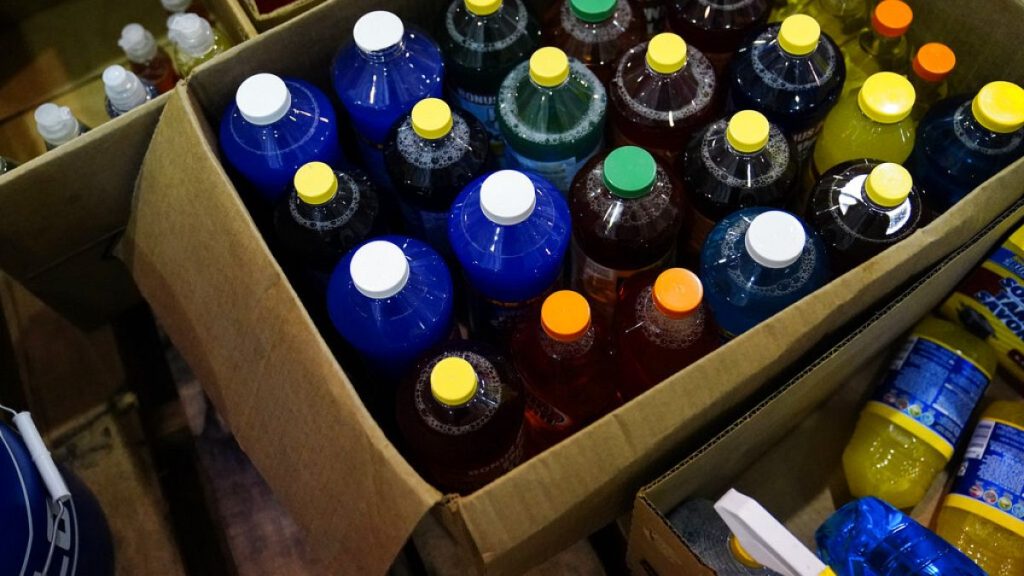Summarize this content to 2000 words in 6 paragraphs
Global intake of sugar-sweetened beverages has risen alongside child obesity in recent decades, with the highest consumption levels in Latin America and the Middle East and North Africa.
Kids in nearly every part of the world are drinking more soda and other sugary drinks than ever, and child obesity rates are climbing to match, according to a new study that spans three decades and 185 countries.In 2018, children were having an average of 3.6 servings of sugary drinks per week, a 22.9 per cent increase from 1990 and a much sharper uptick than among adults, according to the study, which was published in The BMJ and led by researchers in the US, Greece, Canada, and Mexico.Child obesity rose in tandem during that time period, and now affects about 160 million kids and teens around the globe.“Our findings should raise alarm bells in nearly every nation worldwide,” Dariush Mozaffarian, the study’s senior author and director of the Food is Medicine Institute at Tufts University in the US, said in a statement.Researchers looked at sugar-sweetened beverages (SSBs), which include sodas, energy drinks, and fruit drinks and exclude 100 per cent fruit and vegetable juices, non-caloric artificially sweetened drinks, and sweetened milk, tea, and coffee.Previous studies have shown that sugar-sweetened beverages are linked to a higher risk of obesity among young people, which in turn is tied to more health problems during adulthood, including type 2 diabetes, heart disease, and certain cancers.“It has a very high price for the health of individuals, not only in childhood but long-term, and also a very high cost to society,” Dr Berthold Koletzko, a paediatrics professor at Ludwig Maximilian University of Munich and the president of the European Academy of Paediatrics, told Euronews Health. He was not involved with the study.In the new report, intake of sugary drinks was higher among older kids and teenagers than among younger children across the globe. In most regions, rates were also higher in urban areas and among children whose parents had higher education levels, though these disparities didn’t exist in high-income countries.That’s likely because in lower-income countries, people in urban areas and those who are highly educated also have more money and are thus more likely to opt for sugary drinks, Koletzko said, while in high-income countries, it’s the other way around.“It’s a question of affordability,” Koletzko said.Regional differencesLatin America and the Caribbean and the Middle East and North Africa reported the highest intake levels overall (9.1 and 7.3 servings per week, respectively). Even so, kids in Latin America had slightly fewer sugary drinks, on average, in 2018 than they did in 1990.Rates fell in Latin America and the Caribbean in the 1990s and early 2000s, and then crept up again more recently – shifts that researchers said reflect the region’s economic trends and the emergence of healthy eating campaigns, as well as industry lobbying against policies to curb sugary drink intake over the past 30 years.“The influence of multinational corporations responsible for ultra-processed foods, marketing strategies targeted at young people, lack of (or poor) regulatory measures to limit the intake of SSBs have also been consistently observed in Latin America and other regions with improving economies,” researchers said.High-income countries, such as those in Western Europe and North America, also saw a decrease in children’s sugary drink consumption between 2005 and 2018 after the rate surged between 1990 and 2005. That could be due to rising obesity rates and the introduction of less sugary alternatives, among other factors.Notably, Sub-Saharan Africa saw a 106 per cent increase in sugary drink intake during the study period, reaching an average of 4.2 servings per week in 2018 and making it a “growing problem” for the region, researchers said.Among the 25 most populous countries for children, Mexico reported the highest sugary drink intake among kids in 2018 (10.1 servings per week), followed by Uganda (6.9 servings), Pakistan (6.4 servings), and South Africa and the US (6.2 servings each).Meanwhile, India and Bangladesh saw the lowest levels, with 0.3 servings per week each.In much of the world, kids have sugary drinks roughly every day. In 56 of the 185 countries analysed, children drank an average of at least seven servings per week, representing 238 million kids and teenagers, or 10.4 per cent of young people worldwide.The findings underscore “the need for targeted education and policy interventions to change behaviour early on and prevent the adverse outcomes associated with sugar-sweetened beverage intake in childhood,” Laura Lara-Castor, the study’s first author and a postdoctoral researcher at the University of Washington, said in a statement.Those interventions could include taxes, regulations on labelling and marketing for sugary drinks, and efforts in schools to curb kids’ access to the products, researchers said.“The intakes and trends we’re seeing pose a significant threat to public health, one we can and must address for the future of a healthier population,” Mozaffarian said.


